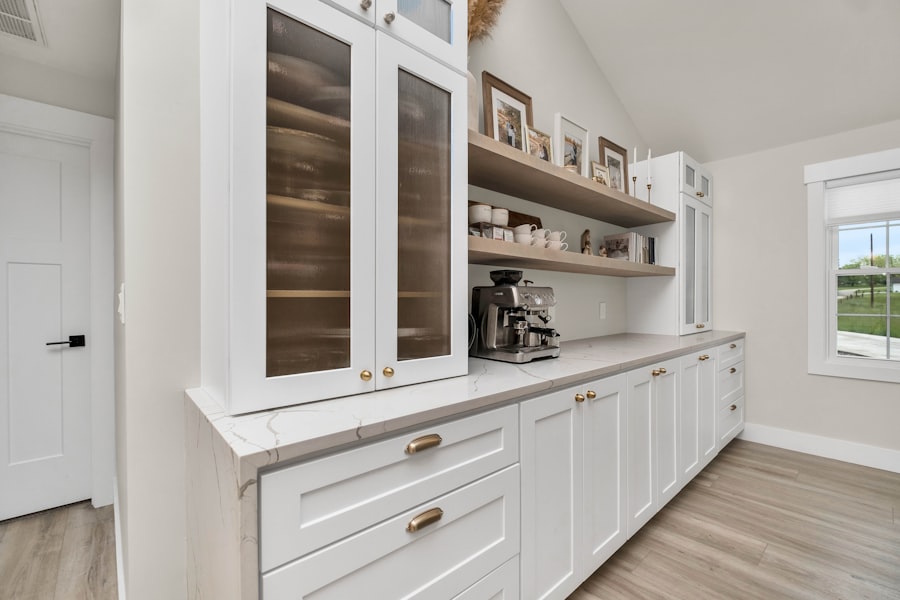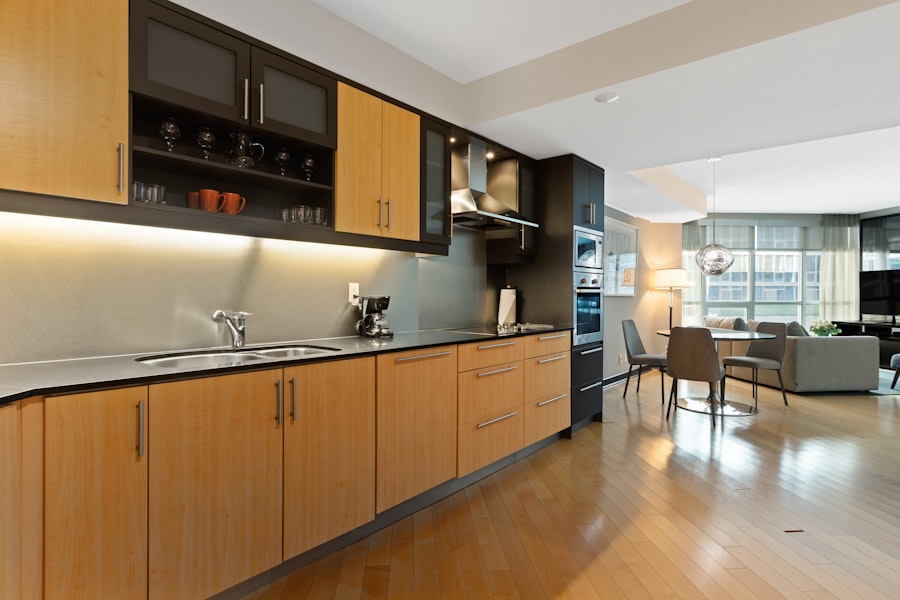Custom cabinets offer a multitude of advantages that can significantly enhance both the functionality and aesthetic appeal of a space. One of the primary benefits is the ability to tailor the cabinets to fit the specific dimensions and layout of a room. Unlike pre-manufactured options, which often come in standard sizes, custom cabinets can be designed to utilize every inch of available space.
This is particularly beneficial in kitchens and bathrooms, where awkward corners or low ceilings can make it challenging to find suitable storage solutions. By working with a skilled cabinet maker, homeowners can create cabinets that not only fit perfectly but also complement the overall design of their home. Another significant advantage of custom cabinets is the opportunity for personalization.
Homeowners can choose from a wide array of materials, finishes, and hardware to create a look that reflects their individual style. Whether one prefers a sleek, modern aesthetic or a more traditional, rustic feel, custom cabinets can be designed to meet those preferences. This level of customization extends beyond mere appearance; it also encompasses functionality.
For instance, homeowners can incorporate specialized features such as pull-out shelves, built-in dividers, or integrated lighting, enhancing both usability and convenience. The result is a unique cabinetry solution that not only meets practical needs but also serves as a focal point in the home.
Key Takeaways
- Custom cabinets offer personalized design and enhanced functionality tailored to your space.
- Selecting the right style and design ensures your cabinets complement your home’s aesthetic.
- Customizing features like shelves, drawers, and hardware maximizes usability and convenience.
- Quality materials and professional craftsmanship contribute to durability and long-lasting beauty.
- Proper budgeting and regular maintenance help protect your investment and keep cabinets looking new.
Choosing the Right Style and Design
Selecting the appropriate style and design for custom cabinets is crucial in achieving a cohesive look throughout a home. The first step in this process involves assessing the existing decor and architectural elements of the space. For instance, if a home features a contemporary design with clean lines and minimal ornamentation, opting for sleek, flat-panel cabinets in a high-gloss finish may be ideal.
Conversely, in a traditional setting characterized by ornate moldings and classic furnishings, raised-panel cabinets with rich wood tones could enhance the overall ambiance. In addition to considering the existing decor, it is essential to think about the intended use of the cabinets. For example, kitchen cabinets should not only be visually appealing but also practical for cooking and entertaining.
This might involve selecting designs that allow for easy access to frequently used items or incorporating open shelving for displaying dishware. Similarly, bathroom cabinets should prioritize functionality while maintaining an elegant appearance. By carefully evaluating both style preferences and practical needs, homeowners can make informed decisions that lead to a harmonious and functional cabinetry solution.
Customizing Cabinet Features

The customization of cabinet features is where homeowners can truly make their cabinetry unique and tailored to their lifestyle. One popular option is the inclusion of specialized storage solutions that cater to specific needs. For instance, a passionate cook may benefit from pull-out spice racks or deep drawers designed for pots and pans, allowing for easy organization and access.
In contrast, those who entertain frequently might opt for wine racks or glass-front cabinets to showcase their collection of glassware and spirits. Another aspect of customization involves the choice of hardware and finishes. The knobs and pulls selected for cabinets can dramatically influence the overall look and feel of the space.
For example, sleek stainless steel handles may complement a modern kitchen, while antique brass knobs could enhance a vintage-inspired bathroom. Additionally, finishes such as paint or stain can be customized to match or contrast with other elements in the room, creating a cohesive design. By thoughtfully considering these features, homeowners can create cabinets that not only serve their functional purposes but also reflect their personal style.
Maximizing Storage Space
| Storage Solution | Space Efficiency | Cost Effectiveness | Ease of Access | Best Use Case |
|---|---|---|---|---|
| Vertical Shelving | High | Moderate | High | Small rooms, garages |
| Under-bed Storage | Moderate | High | Moderate | Bedrooms with limited closet space |
| Multi-functional Furniture | High | Moderate | High | Living rooms, small apartments |
| Stackable Containers | High | High | Moderate | Basements, attics, closets |
| Wall-mounted Racks | High | Moderate | High | Kitchens, workshops |
| Closet Organizers | High | Moderate | High | Bedrooms, entryways |
Maximizing storage space is one of the most compelling reasons to invest in custom cabinets. Standard cabinetry often falls short in terms of efficiency, leaving homeowners with wasted space or cluttered areas. Custom cabinets allow for innovative solutions that make the most of every square inch.
For example, corner cabinets can be designed with lazy Susans or pull-out shelves that make accessing items in hard-to-reach areas much easier. This not only improves organization but also enhances the overall functionality of the kitchen or bathroom. In addition to optimizing corner spaces, custom cabinets can incorporate vertical storage solutions that take advantage of height.
Tall cabinets can be designed with adjustable shelving or pull-down racks that allow homeowners to store items at various heights without sacrificing accessibility. Furthermore, integrating drawer dividers or pull-out bins can help keep smaller items organized and easily accessible. By focusing on maximizing storage space through thoughtful design and innovative features, custom cabinets can transform cluttered areas into well-organized havens.
Selecting Quality Materials
The selection of quality materials is paramount when it comes to custom cabinets, as it directly impacts both durability and appearance. Homeowners have a wide range of options available, from solid hardwoods like oak and maple to engineered materials such as plywood and MDF (medium-density fiberboard). Solid wood offers timeless beauty and strength but may require more maintenance over time due to its susceptibility to warping or cracking in humid environments.
On the other hand, engineered materials provide excellent stability and are often more resistant to moisture, making them suitable for areas like kitchens and bathrooms. In addition to wood types, the choice of finishes plays a critical role in the longevity and aesthetic appeal of custom cabinets. High-quality paints and stains not only enhance the visual characteristics of the wood but also provide protection against wear and tear.
For instance, a durable polyurethane finish can safeguard against scratches and moisture damage while maintaining a beautiful sheen. Homeowners should also consider hardware materials; opting for solid metal knobs and pulls can ensure longevity compared to cheaper plastic alternatives. By investing in quality materials throughout the cabinetry process, homeowners can enjoy beautiful and functional cabinets that stand the test of time.
Working with a Professional Cabinet Maker

Collaborating with a professional cabinet maker is essential for achieving high-quality custom cabinetry that meets specific needs and preferences. A skilled cabinet maker brings expertise in design, construction techniques, and material selection that can elevate the final product beyond what is achievable through DIY methods or mass-produced options. During the initial consultation, homeowners should communicate their vision clearly while being open to suggestions from the cabinet maker based on their experience.
The design process typically involves creating detailed plans that outline dimensions, styles, features, and finishes. A professional cabinet maker will often provide 3D renderings or sketches to help visualize how the final product will look within the space. This collaborative approach ensures that all aspects are considered before construction begins, minimizing potential issues down the line.
Additionally, working with an experienced cabinet maker often results in superior craftsmanship; they possess the skills necessary to create intricate details such as dovetail joints or custom moldings that enhance both durability and aesthetics.
Budgeting for Custom Cabinets
Budgeting for custom cabinets requires careful planning and consideration of various factors that influence overall costs. The first step is determining how much one is willing to invest in cabinetry based on personal financial circumstances and project scope. Custom cabinets typically come at a higher price point than stock options due to their tailored nature; however, they offer long-term value through enhanced functionality and durability.
Several elements contribute to the overall cost of custom cabinetry, including materials chosen, complexity of design, and labor involved in construction and installation. Solid woods tend to be more expensive than engineered materials; thus, selecting a combination may help balance quality with budget constraints. Additionally, intricate designs with specialized features will naturally increase costs compared to simpler styles.
Homeowners should also factor in potential additional expenses such as hardware selection and finishing options when creating their budget. By establishing clear financial parameters early on, homeowners can work collaboratively with their cabinet maker to find solutions that meet both aesthetic desires and budgetary limitations.
Maintaining and Caring for Custom Cabinets
Proper maintenance and care are essential for preserving the beauty and functionality of custom cabinets over time. Regular cleaning is one of the simplest yet most effective ways to keep cabinetry looking its best. Homeowners should use gentle cleaning solutions specifically designed for wood surfaces rather than harsh chemicals that could damage finishes or wood grain.
A soft cloth dampened with water or a mild soap solution can effectively remove dirt and grime without causing harm. In addition to routine cleaning, it’s important to address any signs of wear or damage promptly. For instance, if cabinet doors begin to sag or hinges become loose over time, these issues should be repaired immediately to prevent further damage.
Periodically checking for signs of moisture damage—such as warping or discoloration—is also crucial, especially in areas prone to humidity like kitchens and bathrooms. Applying furniture polish or wax periodically can help protect finishes from scratches while enhancing their luster. By implementing these maintenance practices, homeowners can ensure their custom cabinets remain beautiful and functional for years to come.



